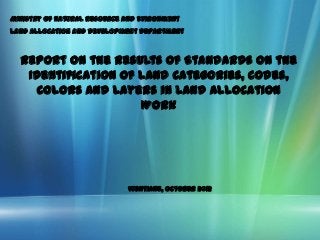
Lupws session 2 land classes_DLUP_MONRE_eng_no maps
- 1. Ministry of Natural Resource and Evironment Land Allocation and Development Department Report on the Results of Standards on the Identification of Land Categories, Codes, Colors and Layers in Land Allocation Work Vientiane, October 2012
- 2. • Presentation Topics I. Background II. Objectives and purposes III. Previous implementation IV. Results V. Lessons learned
- 3. I. Background on identification of land categories, code, colors, and layers Identification of land categories, codes, colors, and layers is a key factor on land allocation and other works relating to all types of mapping. In the past, many sectors and stakeholders used different codes, colors, and database, caused confusion to the users. Thus, MONRE (Land Allocation and Development Department) coordinated with GIZ and TABI organized a meeting to improve and create new standard with participation from various stakeholders and sectors in order to identify the standard, colors, codes, layers, and land use categories to obtain the reading of the same page and apply in the actual works.
- 4. II. Objectives and purposes 1. to obtain concurrent map information in all works relating to the maps. 2. to obtain fast and promptly summarization of the data and information. 3. to develop the modernized, standardized, quality, clear and easy database for the user. 4. to disseminate the database on the land and natural resources for better public understanding. 5. to allow the relevant agencies being able to use the data for promote and use within their work scope and targets in compliance with the applicable laws.
- 5. III. Previous implementation Land categorization has been expanded from the law on land No. 04/NA, dated 21 October 2003 which divided into 3 levels as follows: • Level 1: Main category – the large areas of land which is defined in accordance with the law on land and used for the large scale of maps, particularly in national, provincial, district, and Koumban levels. • Level 2 : Sub-categories or land use management zones – the zones defined for management and use which is able to divide into sub-categories of land, particularly land allocation map in village level. • Level 3: Land use management areas – the areas with detailed defining and allocating, particularly the work with detailed survey and allocation of each sector or projects such as urban planning maps, specific land piece
- 6. Example 01 : Use of database in each level 1. Layer of the locations and management areas in district level PCODE P_name_E P_name_L DCODE D_name_E D_name_L Area 07 Houaphan . 07 04 M. Viengxai . 2. Layer of the locations and management areas in Koumban level PCODE P_name_E P_name_L DCODE D_name_E D_name_ GCODE G_name_E G_name_L Area L 07 Houaphan . 07 04 M. . 07 04 002 G. Sonephet . Viengxai 3. Layer of the locations and management areas in village level PCODE P_name_E P_name_ DCODE D_name_E D_name_ GCODE G_name_E G_name_L VCODE V_name_E V_name_L Area L L 07 Houaphan . 07 04 M. . 07 04 002 G. Sonephet . 07 04 002 104 B. Napoung . Viengxai
- 7. 4. Layer of the land category database. Layer of the land category database in level 1 and 2 PCODE DCODE CODE VCODE LU_GCODE LU_Gname_E LU_Gname_L LU_VCODE LU_Vname_E LU_Vname_L Area 07 07 04 07 04 002 07 04 002 104 BZ BUILDING UP LAND BZ_2 State construction land Layer of the land category database in level 3 and 4 LU_VCODE_3 LU_3name_E LU_3name_L LU_VCODE_4 LU_4name_E LU_4name_L Area BZ_402 School BZ_01 Mr Si . Example 02: Use of the code and colors of each land category in each level
- 8. IV. Results 1. Strengths: - Made the concurrent database in each level with basic database. - Made the concurrent colors for the land parcels by using the code. - Made the technicians being comfortable with applying the codes and colors of the land parcels. - Made the data summarization being faster and easier. - Made the data users being comfortable.
- 9. 2. : - . - , , . - . - .
- 12. V. Lessons learned: - Some points of code and colors of the land parcels required improvement, particularly adding some necessary land categories and modify some land parcel colors as follows: 1. The codes should be broader expanded for forest land, agricultural land, and cultural land such as conservation forests, protected forests, exploitation forest; those need to create the codes and colors for the national proected forest, provincial protected forest, district protected forest, and even village protected forest. 2. There should be codes and colors for vacant land and stone garden, and etc. not stated in the land law. - There should be fund or data development unit to summarize and clean the data. - There should be training on the use of standard in deep and throughout manner for the users.
- 13. Thanks